Abstract
In this study, a type of fly ash and iron tailing powder were used as a binary supplementary cementitious material (SCM) and two different mechanically activated procedures, named coalescent activation and separated activation, were carried out to improve the pozzolanic reactivity. Then, three binary supplementary cementitious materials were used to replace 30 wt% of ordinary Portland cement to develop cemented mortars, and the compressive strength, hydration products, and micro-structure were studied. The experimental results indicated that the activated supplementary cementitious materials increased the compressive strengths of the mortars by 5.4% and 13.2%, negligibly changed the hydration product types, and impacted the quantity only. The application of SCMs also prolonged the setting time and decreased the hydration rate, profiting the application. Simultaneously, the micro-pore structure was ameliorated, and the porosity decreased. Therefore, comprehensively considering the improved mechanical behavior and inexpensive cost, the activated binary SCM can be considered an ecological and economical admixture, especially for the coalescent activation procedure.
1. Introduction
Concrete is supposed to be the most widely used building material worldwide, of which ordinary Portland cement (OPC) is the most used cementitious binder due to its excellent applicability, mechanics, and durability properties [1,2]. However, according to the statistical data, the production of OPC contributed almost 7% of the total carbon dioxide emissions, which is detrimental to the environment [3,4]. Furthermore, the consumption of natural limestone and clay as the dominant raw materials in the preparation of OPC also prevents sustainable development [5,6]. Hence, it is necessary to find an environmental and ecological substance to completely or partly recline OPC and reduce the carbon impact.
In recent years, the development of supplementary cementitious materials (SCMs) has been widely reported and studied to partially replace OPC [7,8]. Initially, some natural minerals, such as pozzolana and kaolinite, were welcomed in the concrete industry. However, the exploitation and application of these materials is also offensive to green development. Therefore, generally, some active by-products are very suitable for use in the development of cementitious composites as a substitute for OPC, such as ground granulated blast furnace slag, fly ash, silica fume, and steel slag [9,10]. The incorporation of SCMs not only plays a role in filling the pores and reinforcing the packing structure but also reacts with portlandite from cement hydration and produces additional hydration products. The application of SCMs has been extensively reported to improve the workability, relieve the interface transition zone, increase the mechanical properties, and even enhance the durability. However, with the extremely large demand for concrete, these high-pozzolana SCMs are also in short supply, which causes a concurrent increase in the prices.
In recent studies, series waste materials characterized as efficient, inexpensive, and retrievable have been investigated as a practicable replacement for cement, of which the reactivity is also as good as natural pozzolanic. However, in addition to the economics and environment, the original chemical property is also required. By-products rich in silicon (Si) and aluminum (Al) with fineness and a porous medium are potentially seen as supplementary cementitious materials. Several representative industrial by-products such as steel slag, blast furnace slag, fly ash, silica fume, copper slag, and stone powder have been reported as a substitution for cement [11,12,13,14,15,16]. By-products with sufficient active silicate and aluminate have performance advantages, including a reduction in segregation and improvement of the strength and durability. However, corresponding to the finite ameliorating mechanism of single SCM, the use of blended or binary SCMs is welcomed [17,18]. The association of SCMs is chosen comprehensively, where they have a synergetic effect and mutually overcome the shortcomings [19].
Iron tailings powder (ITP), a typical discharged by-product in mines, is one of the main wastes and leads to many environmental problems in China [20]. Despite the components of tailings being highly related to the characteristics of ore, silica-based quartz is still the dominant phase, which is quite inactive and hard to react in a pozzolanic reaction [21,22]. On the other hand, fly ash (FA), mainly from coal-burning in thermal power stations, is also a preponderant solid waste in China [23,24]. Although its primary chemical components are silica and aluminate, reported as the pozzolana, fly ash still has an unsatisfactory property in the concrete industry due to its inactive siliceous surface [25]. Hence, mechanical activation is considered to bring out the physical and physicochemical translations of minerals by mechanical force. Generally, the most significant impact mechanism of mechanical activation is to change the particle size distribution (PSD). Then, distortion and dislocation are reported to occur during the refining process, forming many activation centers with a decrease in the activation energy of the reactions [26,27]. A number of studies have investigated the mineralogical changes in raw materials affected by mechanical activation [12,28,29]. However, for iron tailings and fly ash, much of the literatures has investigated the limitation of grinding on single materials, especially in actual applications [25,30]. The particle size gap between the materials and the grinding media negatively affects the grinding efficiency. Hence, it is necessary to develop a new and efficient method to activate these two wastes.
In view of the contradiction among the costs of the raw materials, activation, and performance, in this study, FA and ITP, extremely common and cheap by-products in China, were used as raw materials to produce binary SCM. Moreover, an inexpensive grinding process was used to activate their pozzolanic reactivity. Firstly, two different procedures of mechanically activated methods were carried out, replacing 30% of the weight of OPC to prepare blended cement. Then, the setting time, hydration heat, compressive strength, hydrates’ performance, and microstructure were studied to discuss the effect of mechanically activated SCM on the performance of cemented paste and mortar.
2. Materials and Methods
2.1. Cementitious Binder and Aggregate
The experimental materials in this study included cementitious binder and aggregate. A type of P O 42.5-grade ordinary Portland cement (OPC) conforming with Standard GB175-2007 [31] and fly ash (FA) were supplied by Jianhua Building Materials Co., Ltd. (Shenyang, China). Iron tailing powder was collected from Waitoushan Iron Mine located in Liaoning Province. The chemical compositions of the Portland cement, IOTs, and FA are shown in Table 1. Figure 1 describes the mineralogical properties of FA and ITP. It is clear that the dominant quartzose mineralogical phase in ITP causes its very low reactivity and pozzolanic activity. Similarly, the peaks for the quartz phase are also observed in FA, but the intensity values are much lower, indicating the lesser content of quartz. Contrarily, silicate-aluminate crystalline is also abundant in FA, which identifies the potential pozzolanic reactivity that requires activation.

Table 1.
The chemical compositions of cementitious binders (by weight%).
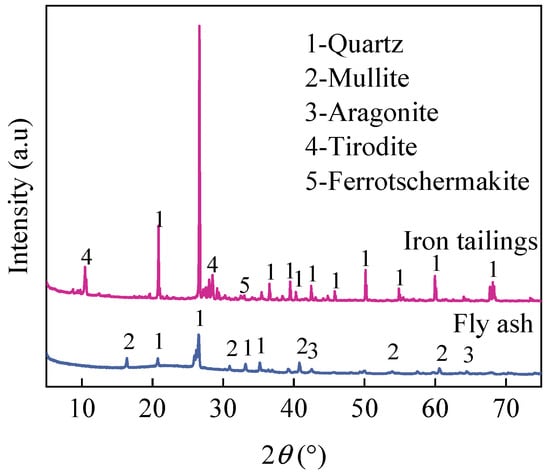
Figure 1.
Mineralogical properties of FA and ITP.
In addition, a type of well-graded ISO standard sand was used as the dominant aggregate to prepare cementitious mortar.
2.2. Preparation and Mechanical Activation of Binary SCMs
According to Chinese Standard 12957-2005 [32], to prepare binary supplementary cementitious materials, FA and ITP, characterized by a 2:1 weight ratio, were mixed directly as the untreated raw binary SCM, named R. Furthermore, to mechanically activate the raw materials, a planetary ball mill machine and zirconia balls were applied to mechanical grind the raw materials. The zirconia balls matched the dimensional proportions of 20 mm:16 mm:12 mm:4 mm = 1:4:6:2, wt.%. In order to estimate the divergence and effect of the mechanically activated method, two different grinding procedures were carried out. For both procedures, the weight ratio of FA to ITP was fixed as 2.
- (1)
- Separated activation or the single-grind method (SG). A grinding procedure was first carried out for ITP and FA, where the weight ratio of the ground materials to the zirconia balls was fixed as 0.5. ITP and FA were individually ground for 1h. Afterwards, the ground ITP and FA were stirred and mixed uniformly, defined as SG;
- (2)
- Coalescent activation or mixing grind (MG). Different from the SG method, another activation method consisted of the mixing of equivalent proportions of ITP and FA. Then, the mixture was ground with the same weight ratio and ground time, defined as MG.
2.3. Mix Design
In order to investigate the effect of the binary supplementary cementitious materials and different activation methods on the properties of the OPC composite materials, 30 wt% of OPC was replaced by R, SG, or MG, labeled as R30, SG30, and MG30, respectively. In detail, OPC, SCM, and ISO sand were first mixed for 3 min, ensuring the homogeneity of the solid materials. Then, pure water was added, and the mixture was mixed for another 2 min in a w/b ratio of 0.5 following the Chinese Standard GB/T 17671-1999 [33]. Meanwhile, cemented mortar with only OPC as the binder was also developed as a reference, described as C100. Then, all the fresh slurry was transferred into molds (40 mm × 40 mm × 160 mm) and cured in curing conditions of 20 ± 1 °C and 95 ± 2% R.H. for 7 and 28 days.
2.4. Testing Methods
2.4.1. Setting Tests
To investigate the effect of the binary SCMs and mechanical activation methods on the setting time of the cementitious pastes, a Vicat apparatus was used to determine the initial and final setting times of the specimens following the ASTM C191 standard test method, where the proportion of composites was the same as that of the mortar without aggregate.
2.4.2. Hydration Heat
In this study, an 8-channel microcalorimeter (TAM Air, TA Instruments, Newcastle, DE, USA) was used to measure the heat flow of the cemented pastes in the first 72 h of curing. The experimental testing procedure was conducted in temperature conditions of 20 °C.
2.4.3. Compressive Strength Tests
The compressive strength of the cementitious mortar specimens was tested after curing for 7 and 28 days following the GB/T 17671-1999 Chinese standard [33]. The compressive strength tests were conducted by a computerized loading equipment (YAW-300, Luda, Shanghai, China). The specimens were loaded under a velocity of 2.4 kN·s−1, reaching the maximum compressive strength. For each group of specimens, triplicate tests were carried out and the mean value was defined to measure the compressive strength.
2.4.4. X-ray Diffraction
The X-ray diffraction patterns of the hardened paste were characterized using a Rigaku Ultima IV type (Rigaku, Beijing, China) to investigate the mineralogical phase of the hydrates. A piece of hardened paste was collected and powdered after curing for 28 days, with a scanning range of 5~50° and velocity of 5°/min.
2.4.5. Derivative Thermogravimetric Analysis
To quantify the content of the hydrates, thermogravimetric and derivative thermogravimetric analyses (STA409PC, Netzsch, Shanghai, China) were performed to further analyze the hardened paste. The specimens were heated from room temperature to 1000 °C at a rising rate of 15 °C/min under an N2 atmosphere.
2.4.6. Scanning Electron Microscopy
Similar to the previous SEM test, platinum-conducting film was coated on the 1 mm hardened cement piece surfaces to increase the electrical conductivity, and SEM was used to observe their hydration products and structures.
3. Results
3.1. Transitions of Binary SCM during Mechanical Activation
3.1.1. Particle Size Distribution
Figure 2 represents the PSD testing result of the raw materials and three SCMs. Compared to OPC, the particle size of ITP is much coarser, but FA is a litter finer. However, the partial FA grains are still coarser than that of OPC, the size of which is higher than 50 μm. The coarser particle size results in a lower specific surface area, impacting the reaction between the raw materials and portlandite. Meanwhile, the crystallinity and activity of the mineral inside the materials might also increase, and a poorer packing model will also probably occur. In view of this, mechanical activation, i.e., the grinding procedure, is required. Furthermore, both grinding methods significantly decreased the particle size of SCMs, where the concentrative range was reduced from about 100 to 0.6~10 μm. This indicates that the mechanical activation effectively increased the specific surface area of the materials, which is described as a dominant factor that improves the potential pozzolanic reactivity of silicate aluminate. Except for the pozzolanic reactivity, Seraj et al. [34] concluded that a finer SCM could also enhance the nucleation effect and development of hydrates, which partially compensates for the dilutionary effect resulting from the replacement of cement with a slower reactive pozzolanic material. Therefore, the particle size distributive property has a critical influence on the performance of SCM.
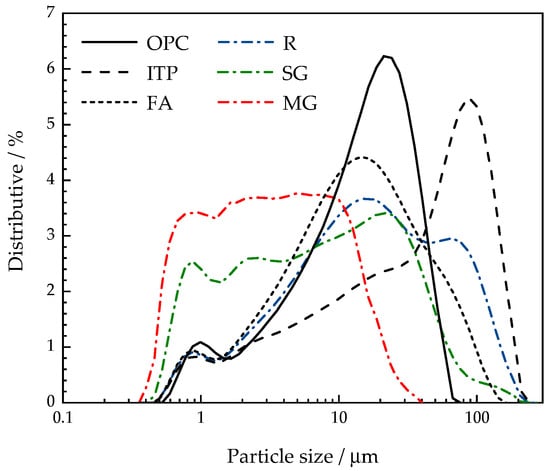
Figure 2.
Particle size distribution of raw materials, R, SG, and MG.
Interestingly, MG represented the finest particle size and most submicron granules, indicating that grinding binary SCM with a premixing process could have a significant effect on the refinement of the particle size and increase in the specific surface area of the raw material. The gap between the efficiencies of the two activation methods could be explained as the divergence of the series ground parameters. As shown and discussed in Figure 1 and Section 2.2, the dimensional gap between the two raw materials (lower than 150 μm) and grinding balls (minimum of 4 mm) was exceedingly prominent. Hence, during the SG method, although the raw materials were ground separately, the ground degree was insufficient and the decline in the particle size distribution was limited, resulting in a relatively poorer refinement effect compared to the MG method. On the contrary, when the ITP and FA particles were ground together, the hard quartz from ITP acted as a supplementary grinding media, which destroyed the crystal structure of the FA grains, which is named the micro-ball effect. Since the particle sizes of ITP and FA were similar, the influence of the ITP particle was better than that of the coarser zirconia balls, leading to a much finer size distribution. Furthermore, considering the heat absorption process, the mechanical-chemical reaction might possibly account for the enhancement of the pozzolanic behavior of the binary SCMs. In summary, the MG method activated the potential pozzolanic effect of the binary of ternary materials better.
3.1.2. Morphology
Figure 3 shows the morphological transformation of the raw materials, SG, and MG. It can be observed in Figure 3a that the morphology of the untreated ITP grains is irregular and the partial particles have a rod or lamellar shape with a rough and angular surface. The FA grains are mostly spherical with a smooth surface and regular shape. After mechanical activation, gradual refinement of the particle size and morphological change were observed for both ITP and FA.
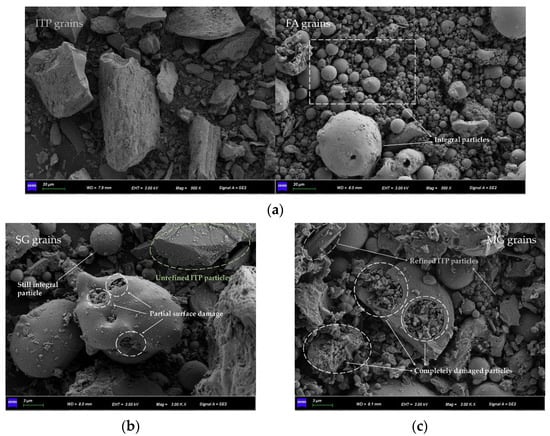
Figure 3.
Micro-morphological patterns of (a) raw ITP and FA, (b) SG, and (c) MG.
Figure 3b shows the apparent morphology of the particle group after mechanical grinding using the SG method. Small holes are observed on the surface of the FA particles damaged by mechanical force, and a particle size of less than 3 μm is also detected. It is also observed that most FA and ITP grains are relatively complete, especially for some particles, with only slight cracks and holes appearing on the surface. Only very few grains are destroyed, resulting in fragments with a smaller particle size.
However, when another MG method was employed, the degree of grinding was more obvious than that of the SG method, as shown in Figure 3c. Except for surface abrasion and holes, completely broken FA and ITP particles and the production of many fine fragments are also observed. It can also be observed that FA was ground into a hemisphere with a particle size <3 μm. The halfsphere-shaped particles and ITP particles with few corners increased significantly, and the surface of the fine ITP particles gradually became spherical from the previous irregular shape. These experimental phenomena indicate that the both grinding procedures could significantly affect the morphological properties of raw materials, breaking the inactive external surface and releasing reactive silicate-aluminate, while the MG method had a better influence.
3.1.3. FT-IR Analysis
A comparison of the chemical bond of the two SCMs is shown in Figure 4.
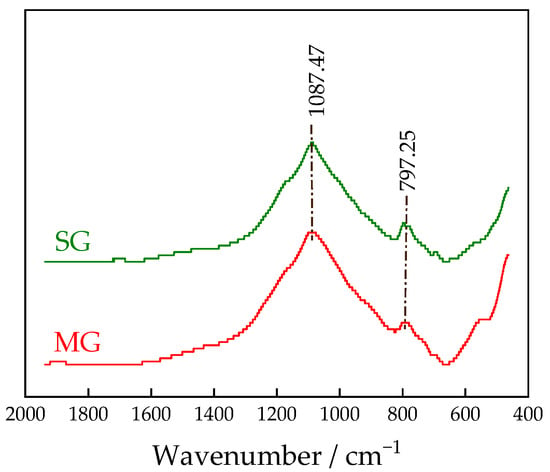
Figure 4.
FT-IR spectra of SCM during the SG and MG method.
This indicates that the bands of the two SCMs with different ground methods are rare and mainly concentrated in the low wavenumber region, where the peaks are mainly around 1087 and 797 cm−1, which are related to the asymmetrical and symmetric stretching vibration of Si-O bonding, respectively.
The comparison between the two curves shows that the MG sample has broader peaks for both bonds, which might be due to the electrification of the new fracture surface of the particles. The caudal Si-O bond from the grains leads to the adsorption polymerization between the cross-sections and the formation of new Si-O-Si bonds. When the integrity and symmetry of the crystal are damaged, the spectral band is simplified and widened. Hence, the analytical result indicates that the symmetry and integrity of the crystal in the MG procedure are greatly transformed during the grinding process, where symmetrical and stable crystals are destroyed and transformed into an amorphous state. The FT-IR spectra also prove the activated pozzolanic behavior of SCM during the MG method.
3.2. Hydration Kinetics
Figure 5 shows the hydration heat flow rate of the three tested specimens and reference OPC. Three peaks can clearly be observed for all four specimens, resulting from the different exothermic behavior of the cementitious binders. The first exothermic peak (peak 1) appears immediately after the mixing of the raw materials with water, which is generally understood as the release of heat from the wetting and dissolution of the particles. The second and third peaks (peaks 2 and 3) are reported to correspond to the hydration of C3S and C3A from cement, respectively. It is very clear that the OPC paste has the highest hydration rate, and all three SCMs significantly relieved the hydration heat release of OPC, which is consistent with previous studies [35,36,37]. The decline in the hydration heat can mainly be explained as the dissolution effect of cement due to the mass loss. The hydration degrees of C3S and C3A deteriorated as the content from the cement declined, leading to lower production of C-S(-A)-H and a lower hydration heat.
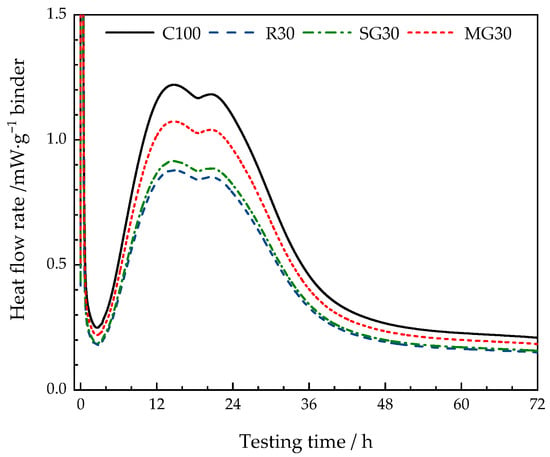
Figure 5.
Calorimetry testing result of OPC and blended cemented paste.
Comparatively, considering the three cement blends with different activated methods, it is also worth noting that the hydration heat value represents an increasing tendency. MG30 has the highest hydration heat flow while the R30 has the lowest. This experimental phenomenon is mainly due to the different PSD from the different grinding procedure, as shown in Figure 2. The particle size distribution of SCM had a dramatical influence on the nucleation effect, where the wide specific surface provides a site for the hydration of cement particles and the development of hydration products [37,38,39]. Meanwhile, a higher hydration heat was reported as a primary factor that dominates the shrinkage behavior and microcrack growth of cement composites [40,41,42]. It is clear that the utilization of SCM as a substitute of OPC can effectively relieve the high hydration heat flow; however, although the nucleation effect could partially compensate for the dilutionary effect of a lower cement content, the influence of SCM on the mechanical properties of cement composites is still noteworthy.
3.3. Setting Time
Table 2 shows the setting testing result of the mixtures. It can be concluded that the incorporation of all three SCMs significantly prolonged the setting time of the blended cement, which is in agreement with the existing literature showing that the addition of SCM delays the setting behavior [43,44,45]. Similar to the hydration kinetics testing, the retarded initial and final setting time can mainly be attributed to the dilution effect. The reduced cementitious particles led to lower production of hydrates, deteriorating the bonding of grains. It should be concurrently noted that the two mechanical activations simultaneously accelerated the setting of the blended cemented paste, and the combination before grinding represented showed a more evident effect. This can be attributed to the additional sites from the finer particles and more expansive surface areas of SCMs, which provided more preferential nucleation of hydration products and accelerated the formation of the first percolated backbone [12,46,47]. Furthermore, the MG method also decreased the gap between the initial and final set, which is believed to be much more beneficial for the construction field [48].

Table 2.
The initial and final setting time of cemented paste (min).
3.4. Compressive Strength
The compressive behavior evolution of cementitious mortars is shown in Figure 6. Different modifications of the compressive strength behavior caused by the addition of various binary SCM and curing times are observed. The reference C100 showed the highest compressive strength while the blended cement with binary SCM showed a decreased trend after both 7 and 28 days of curing. For the early behavior (7 days), the decline in the compressive strength was 33.5%, 26.8%, and 24.6% for R30, SG30, and MG30, respectively. This result means that all three SCMs only showed poor pozzolanic behavior during the early curing. When the curing time reached 28 days, the pozzolanic reactivity improved substantially, especially for MG30, which is almost equal to the reference C100. Furthermore, SG30 and MG30 showed a relatively higher strength compared to R30, signifying that the mechanical activation positively enhanced the pozzolanic reactivity. It has been widely reported that the mechanically activated procedure can effectively break the crystalline structure and chemically stable bond, producing amorphous silicate-aluminate. Han et al. also concluded that a finer particle size filled the micro (or nano) pore and ameliorated the interfacial transition zone between sand and hardened cemented paste. A dense structure of the interfacial transition zone was also beneficial to the development of compressive strength [49]. Meanwhile, the combination of FA and ITP could compensate for the mutual defect. The rough surface meant that the ITP grains mainly acted as inert material while the chemically active mineral in FA could participate in the pozzolanic reaction better, leading to the associative effect of binary SCMs.
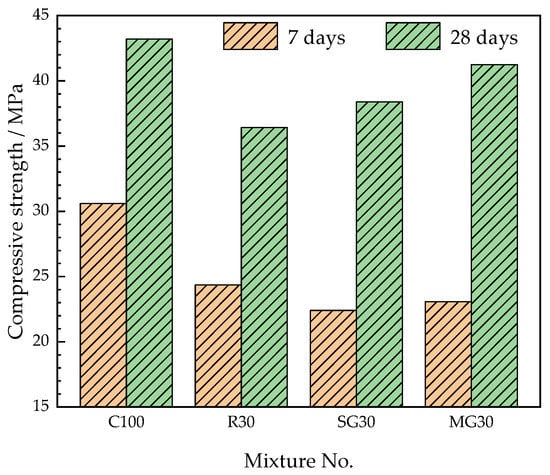
Figure 6.
Compressive strength of cemented mortars.
After 28 days of curing, the decline in the compressive strength was decreased to 15.7%, 11.1%, and 4.6%, respectively. This indicates that a long curing age was necessary for the dilatory pozzolanic reaction between SCM and portlandite. Meanwhile, the gap between pure OPC and MG30 was exceedingly low. According to the Chinese Standard 12957, mineral admixture, of which the activity index (defined as the compressive strength ratio of 30 wt% SCM to pure cement) could be used as a substitute for OPC, is applied in the construction field. Comprehensively, considering the low cost and adequate mechanical performance, the application of ITP-FA binary SCM is feasible and positive.
3.5. Hydration Products
Figure 7 represents the XRD patterns of cemented paste after curing for 28 days. The dominant hydrates were Ca(OH)2 and C(-A)-S-H, which were mainly produced by the hydration reaction of cement particles. A small amount of CaCO3 was also detected due to the carbonation of Ca(OH)2. Meanwhile, quartz from the raw materials ITP and FA was also observed. This pattern demonstrates that the incorporation of all three binary SCMs does not change the type of hydration product. However, some interesting experimental phenomena should be noted. As discussed before, the character of SCM was mainly attributed to the pozzolanic reaction, where the active silicate-aluminate reacted with Ca(OH)2, producing excess C-A-S-H. Hence, the intensity of Ca(OH)2 is considered as a measurement of the pozzolanic property of SCM. It is also noted that MG30 showed the lowest peak at about 2 Theta = 18°, indicating that MG30 consumed the smallest content of Ca(OH)2 and showed a consistent compressive strength result.
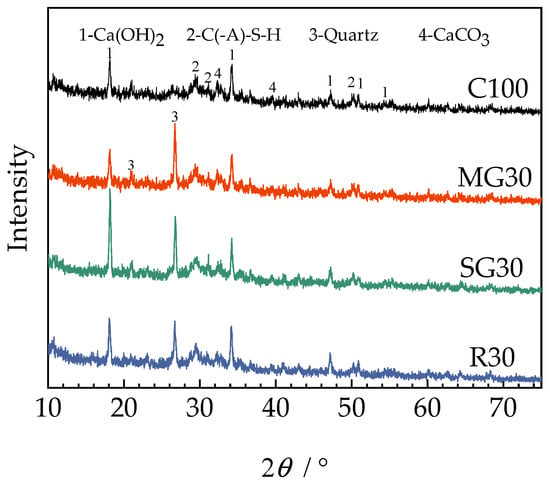
Figure 7.
X-ray diffraction patterns of the cemented pastes.
In order to verify this conclusion, a TG test was also carried out, as shown in Figure 8. The principle peak stage was around 450 °C, which is mainly caused by the thermal decomposition of Ca(OH)2 [50]. Based on the pozzolanic reaction between silicate-aluminate from SCM and Ca(OH)2, the direct decomposition of Ca(OH)2 and CaCO3 indirectly reflects the extent of SCM participating in the secondary hydration reaction, and the calculated Ca(OH)2 contents are tabled in Table 3. It can be concluded that in the 28-day hydration process, the content of Ca(OH)2 in the C100 sample was the highest, and all the blended binders with SCMs showed a decline, which can be explained as the synergism of the illusion effect and pozzolanic reaction. The loss of Ca(OH)2 in the MG30 sample was lower than that in the R30 and SG30 sample with the same cement content, which indicates that more Ca(OH)2 in the MG30 sample participated in the pozzolanic reaction. Further, it is also clear that the MG mechanical activation of binary SCM was more conducive to improving its pozzolanic reactivity than the SG one. The result of the thermogravimetric results also verifies the compressive strength result.
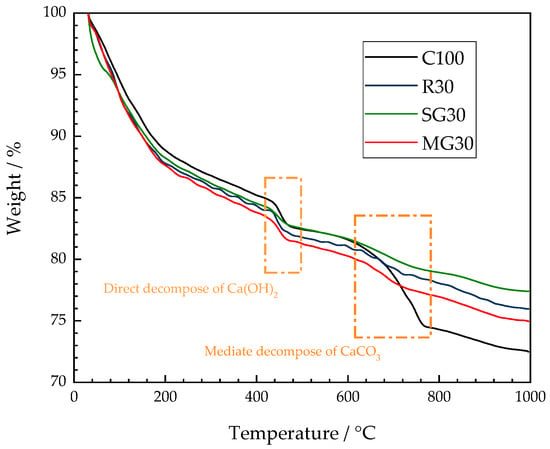
Figure 8.
Thermogravimetric results of the cemented pastes.

Table 3.
Ca(OH)2 content of the cemented pastes.
3.6. SEM Patterns
The micro patterns of cementitious pastes after curing for 28 days are shown in Figure 9. A large number of flaky Ca(OH)2, rod-shaped ettringite crystals, fibrous type I C-S-H gel, and other shapes of C-S-H gel are observed in all four cemented pastes and particularly in C100, which dominantly built the compressive strength. For the three blended cements, a large number of FA and ITP particles are clearly observed, indicating that although activated, the reactivity of the binary SCM is still limited, which explains the deterioration of the mechanical behavior. However, different from other samples, in Figure 9d, a large number of fibrous C-S-H gel and particulate C-S-H gel are alternately distributed and form a dense network together with the particles in MG30, leading to an integrated structure. Meanwhile, the C-S-H gel structure in MG30 is also different from the type II one of the C100, R30, and SG30 samples. The C-S-H gel ends are not bifurcated but directly overlap in a three-dimensional network. This structure shows a denser network shape and enhanced structural stability. At the same time, it is observed that part of the uniform particles such as the C-S-H gel aggregate into a whole, which increases the structural density and is conducive to the development of macro strength.

Figure 9.
Microstructure patterns of (a) C100, (b) R30, (c) SG30, and (d) MG30 after 28 days of curing.
4. Conclusions
In this study, mechanical activation was carried out to enhance the pozzolanic behavior of fly ash and iron tailing powder, and two different methods were developed. Through the experimental test and analysis, the following conclusions can be drawn:
- (1)
- The particle size distributions of the raw materials were significantly decreased using the mechanical activation methods, among which the MG method is the best. The finer SCM can inspire the potential reactivity of the raw material and improve the pozzolanic behavior as a pretreatment for replacing ordinary Portland cement.
- (2)
- The addition of SCMs can dramatically inhibit the hydration heat release, which is applicable for the building industry. In detail, the total heat release of the cementitious binder declined by 28%, 25%, and 12% for R30, SG30, and MG30, respectively. Meanwhile, the finer particle size of MG30 provides a wider hydrating area and presents a nucleation effect. In view of this, MG30 displayed a higher mechanical strength that was only 4.6% lower than that of pure cement after 28 days of curing, which contributed to the production of more hydrates.
- (3)
- The three SCMs had little effect on the type of hydration products but mainly influenced the content. By replacing OPC, the content of portlandite decreased from 8.33% to 6.87%, 6.73%, and 3.36%, respectively, due to the pozzolanic reaction, which is advantageous for ameliorating the interface transition zone, optimizing the microstructure, and improving the performance.
- (4)
- Comparing the two activating methods, MG leads to a finer particle size distribution, higher compressive strength, and denser microstructure. Hence, a premix procedure before grinding is beneficial for enhancing the grinding efficiency and is much more suitable for practical utilization.
Author Contributions
Conceptualization, X.X.; data curation, F.W.; funding acquisition, X.G.; investigation, F.W.; supervision, X.X.; writing—original draft, Y.Z. and X.G.; writing—review and editing, Y.Z. All authors have read and agreed to the published version of the manuscript.
Funding
This research was funded by the Special Project of National Natural Science Foundation of China (52074061, 51974060, U1903216), Science and Technology Plan Project of Shenyang (22322302) and the Fundamental Research Funds for the Central Universities (N2201009).
Data Availability Statement
Not applicable.
Acknowledgments
The authors would like to thank Jilong Gao from Shiyanjia Lab (www.shiyanjia.com, accessed on 28 September 2022) for the hydration reaction analysis and SEM test.
Conflicts of Interest
The authors declare no conflict of interest.
References
- Xing, J.; Zhao, Y.; Qiu, J.; Sun, X. Microstructural and Mechanical Properties of Alkali Activated Materials from Two Types of Blast Furnace Slags. Materials 2019, 12, 2089. [Google Scholar] [CrossRef]
- Korouzhdeh, T.; Eskandari-Naddaf, H.; Kazemi, R. Hybrid artificial neural network with biogeography-based optimization to assess the role of cement fineness on ecological footprint and mechanical properties of cement mortar expose to freezing/thawing. Constr. Build. Mater. 2021, 304, 124589. [Google Scholar] [CrossRef]
- Igliński, B.; Buczkowski, R. Development of cement industry in Poland—History, current state, ecological aspects. A review. J. Clean. Prod. 2017, 141, 702–720. [Google Scholar] [CrossRef]
- Bołtryk, M.; Pawluczuk, E. Properties of a lightweight cement composite with an ecological organic filler. Constr. Build. Mater. 2014, 51, 97–105. [Google Scholar] [CrossRef]
- Kulasuriya, C.; Vimonsatit, V.; Dias, W.P.S. Performance based energy, ecological and financial costs of a sustainable alternative cement. J. Clean. Prod. 2021, 287, 125035. [Google Scholar] [CrossRef]
- Mikulčić, H.; Cabezas, H.; Vujanović, M.; Duić, N. Environmental assessment of different cement manufacturing processes based on Emergy and Ecological Footprint analysis. J. Clean. Prod. 2016, 130, 213–221. [Google Scholar] [CrossRef]
- Aprianti, S.E. A huge number of artificial waste material can be supplementary cementitious material (SCM) for concrete production—A review part II. J. Clean. Prod. 2017, 142, 4178–4194. [Google Scholar] [CrossRef]
- Hadji, T.; Guettala, S.; Quéneudec, M.J. Mix design of high performance concrete with different mineral additions. World J. Eng. 2021, 5, 767–779. [Google Scholar] [CrossRef]
- Quedou, P.G.; Wirquin, E.; Bokhoree, C.J.E. A sustainable approach in using construction and demolition waste materials in concrete. World J. Eng. 2021, 18, 826–840. [Google Scholar] [CrossRef]
- Nécira, B.; Abadou, Y.J. Properties of self-compacting mortar made with various mineralogical sources different types of sands and fillers. World J. Eng. 2021, 18, 861–869. [Google Scholar] [CrossRef]
- Taylor, R.; Richardson, I.G.; Brydson, R.M.D. Composition and microstructure of 20-year-old ordinary Portland cement–ground granulated blast-furnace slag blends containing 0 to 100% slag. Cem. Concr. Res. 2010, 40, 971–983. [Google Scholar] [CrossRef]
- Sun, X.; Liu, J.; Zhao, Y.; Zhao, J.; Li, Z.; Sun, Y.; Qiu, J.; Zheng, P. Mechanical activation of steel slag to prepare supplementary cementitious materials: A comparative research based on the particle size distribution, hydration, toxicity assessment and carbon dioxide emission. J. Build. Eng. 2022, 60, 105200. [Google Scholar] [CrossRef]
- Tian, Y.; Themelis, N.J.; Zhao, D.; Thanos Bourtsalas, A.C.; Kawashima, S. Stabilization of Waste-to-Energy (WTE) fly ash for disposal in landfills or use as cement substitute. Waste Manag. 2022, 150, 227–243. [Google Scholar] [CrossRef] [PubMed]
- Babaahmadi, A.; Machner, A.; Kunther, W.; Figueira, J.; Hemstad, P.; De Weerdt, K. Chloride binding in Portland composite cements containing metakaolin and silica fume. Cem. Concr. Res. 2022, 161, 106924. [Google Scholar] [CrossRef]
- Luo, Y.; Zhou, X.; Luo, Z.; Ma, H.; Wei, Y.; Liu, Q. A novel iron phosphate cement derived from copper smelting slag and its early age hydration mechanism. Cem. Concr. Compos. 2022, 133, 104653. [Google Scholar] [CrossRef]
- Campos, H.F.; Klein, N.S.; Marques Filho, J.; Bianchini, M. Low-cement high-strength concrete with partial replacement of Portland cement with stone powder and silica fume designed by particle packing optimization. J. Clean. Prod. 2020, 261, 121228. [Google Scholar] [CrossRef]
- Antoni, M.; Rossen, J.; Martirena, F.; Scrivener, K. Cement substitution by a combination of metakaolin and limestone. Cem. Concr. Res. 2012, 42, 1579–1589. [Google Scholar] [CrossRef]
- Attia, A.; Guettala, S.; Zaitri, R.J. Using mixture design method to optimizing concretes characteristics made with binary and ternary sands. World J. Eng. 2021, 18, 194–205. [Google Scholar] [CrossRef]
- Parashar, A.; Bishnoi, S. A comparison of test methods to assess the strength potential of plain and blended supplementary cementitious materials. Constr. Build. Mater. 2020, 256, 119292. [Google Scholar] [CrossRef]
- Zhang, N.; Tang, B.; Liu, X. Cementitious activity of iron ore tailing and its utilization in cementitious materials, bricks and concrete. Constr. Build. Mater. 2021, 288, 123022. [Google Scholar] [CrossRef]
- Yao, G.; Cui, T.; Zhang, J.; Wang, J.; Lyu, X. Effects of mechanical grinding on pozzolanic activity and hydration properties of quartz. Adv. Powder Technol. Int. J. Soc. Powder Technol. Jpn. 2020, 31, 4500–4509. [Google Scholar] [CrossRef]
- Lo, K.-W.; Cheng, T.-W.; Lin, W.-T.; Lin, K.-L.; Lee, W.-H. Recycling of light-emitting diode waste quartz sand as a pozzolanic material. J. Clean. Prod. 2020, 258, 120683. [Google Scholar] [CrossRef]
- Li, G.; Zhou, C.; Ahmad, W.; Usanova, K.I.; Karelina, M.; Mohamed, A.M.; Khallaf, R. Fly Ash Application as Supplementary Cementitious Material: A Review. Materials 2022, 15, 2664. [Google Scholar] [CrossRef] [PubMed]
- Herath, C.; Gunasekara, C.; Law, D.W.; Setunge, S. Performance of high volume fly ash concrete incorporating additives: A systematic literature review. Constr. Build. Mater. 2020, 258, 120606. [Google Scholar] [CrossRef]
- Yang, J.; Huang, J.; Su, Y.; He, X.; Tan, H.; Yang, W.; Strnadel, B. Eco-friendly treatment of low-calcium coal fly ash for high pozzolanic reactivity: A step towards waste utilization in sustainable building material. J. Clean. Prod. 2019, 238, 117962. [Google Scholar] [CrossRef]
- Kohobhange, S.P.K.; Manoratne, C.H.; Pitawala, H.M.T.G.A.; Rajapakse, R.M.G. The effect of prolonged milling time on comminution of quartz. Powder Technol. 2018, 330, 266–274. [Google Scholar] [CrossRef]
- Lyu, X.; Yao, G.; Wang, Z.; Wang, Q.; Li, L. Hydration kinetics and properties of cement blended with mechanically activated gold mine tailings. Thermochim. Acta 2020, 683, 178457. [Google Scholar] [CrossRef]
- Li, J.; Hitch, M. Structural and chemical changes in mine waste mechanically-activated in various milling environments. Powder Technol. 2017, 308, 13–19. [Google Scholar] [CrossRef]
- Cheng, Y.; Huang, F.; Li, W.; Liu, R.; Li, G.; Wei, J. Test research on the effects of mechanochemically activated iron tailings on the compressive strength of concrete. Constr. Build. Mater. 2016, 118, 164–170. [Google Scholar] [CrossRef]
- Wang, Y.; Li, Y.; Su, Y.; He, X.; Strnadel, B. Preparation of waste glass powder by different grinding methods and its utilization in cement-based materials. Adv. Powder Technol. Int. J. Soc. Powder Technol. Jpn. 2022, 33, 103690. [Google Scholar] [CrossRef]
- GB175-2007; Common Portland Cement. Standardization Administration of China: Beijing, China, 2007.
- GB/T 12957-2005; Test Method for Activity of Industrial Waste Slag as Addition to Cement. Standardization Administration of China: Beijing, China, 2005.
- GB/T 17671-1999; Test Method of Cement Mortar Strength (ISO Method). Standardization Administration of China: Beijing, China, 1999.
- Seraj, S.; Cano, R.; Ferron, R.D.; Juenger, M.C.G. The role of particle size on the performance of pumice as a supplementary cementitious material. Cem. Concr. Compos. 2017, 80, 135–142. [Google Scholar] [CrossRef]
- Duarte, M.S.; Almada, B.S.; José dos Santos, W.; Lima Bessa, S.A.; Cesar da Silva Bezerra, A.; Paulino Aguilar, M.T. Influence of mechanical treatment and magnetic separation on the performance of iron ore tailings as supplementary cementitious material. J. Build. Eng. 2022, 59, 105099. [Google Scholar] [CrossRef]
- Oey, T.; Kumar, A.; Bullard, J.W.; Neithalath, N.; Sant, G. The Filler Effect: The Influence of Filler Content and Surface Area on Cementitious Reaction Rates. J. Am. Ceram. Soc. 2013, 96, 1978–1990. [Google Scholar] [CrossRef]
- Wang, H.; Hou, P.; Li, Q.; Adu-Amankwah, S.; Chen, H.; Xie, N.; Zhao, P.; Huang, Y.; Wang, S.; Cheng, X. Synergistic effects of supplementary cementitious materials in limestone and calcined clay-replaced slag cement. Constr. Build. Mater. 2021, 282, 122648. [Google Scholar] [CrossRef]
- Yu, R.; Shui, Z. Influence of agglomeration of a recycled cement additive on the hydration and microstructure development of cement based materials. Constr. Build. Mater. 2013, 49, 841–851. [Google Scholar] [CrossRef]
- Ardoğa, M.K.; Erdoğan, S.T.; Tokyay, M. Effect of particle size on early heat evolution of interground natural pozzolan blended cements. Constr. Build. Mater. 2019, 206, 210–218. [Google Scholar] [CrossRef]
- Wang, L.; Yang, H.Q.; Zhou, S.H.; Chen, E.; Tang, S.W. Mechanical properties, long-term hydration heat, shinkage behavior and crack resistance of dam concrete designed with low heat Portland (LHP) cement and fly ash. Constr. Build. Mater. 2018, 187, 1073–1091. [Google Scholar] [CrossRef]
- Wang, L.; Yang, H.Q.; Dong, Y.; Chen, E.; Tang, S.W. Environmental evaluation, hydration, pore structure, volume deformation and abrasion resistance of low heat Portland (LHP) cement-based materials. J. Clean. Prod. 2018, 203, 540–558. [Google Scholar] [CrossRef]
- Won, J.P.; Kim, J.H.; Park, C.G.; Kang, J.W.; Kim, H.Y. Shrinkage cracking of styrene butadiene polymeric emulsion-modified concrete using rapid-hardening cement. J. Appl. Polym. Sci. 2009, 112, 2229–2234. [Google Scholar] [CrossRef]
- Zunino, F.; Bentz, D.P.; Castro, J. Reducing setting time of blended cement paste containing high-SO3 fly ash (HSFA) using chemical/physical accelerators and by fly ash pre-washing. Cem. Concr. Compos. 2018, 90, 14–26. [Google Scholar] [CrossRef]
- Lin, K.L.; Wang, K.S.; Lin, C.Y.; Lin, C.H. The hydration properties of pastes containing municipal solid waste incinerator fly ash slag. J. Hazard. Mater. 2004, 109, 173–181. [Google Scholar] [CrossRef] [PubMed]
- Wilińska, I.; Pacewska, B.; Antonovič, V. Hydration Processes of Four-Component Binders Containing a Low Amount of Cement. Materials 2022, 15, 2192. [Google Scholar] [CrossRef] [PubMed]
- Bentz, D.P.; Ferraris, C.F.; Jones, S.Z.; Lootens, D.; Zunino, F. Limestone and silica powder replacements for cement: Early-age performance. Cem. Concr. Compos. 2017, 78, 43–56. [Google Scholar] [CrossRef] [PubMed]
- Bentz, D.P.; Zunino, F.; Lootens, D. Chemical vs. Physical acceleration of cement hydration. Concr. Int. 2016, 38, 37–44. [Google Scholar] [PubMed]
- Zhu, H.; Ma, M.; He, X.; Zheng, Z.; Su, Y.; Yang, J.; Zhao, H. Effect of wet-grinding steel slag on the properties of Portland cement: An activated method and rheology analysis. Constr. Build. Mater. 2021, 286, 122823. [Google Scholar] [CrossRef]
- Han, F.; Li, L.; Song, S.; Liu, J. Early-age hydration characteristics of composite binder containing iron tailing powder. Powder Technol. 2017, 315, 322–331. [Google Scholar] [CrossRef]
- Mudasir, P.; Naqash, J.A. Influence of MWCNTs on portlandite Ca (OH) 2 hydrates in MWCNT–reinforced concrete. World J. Eng. 2021, 18, 920–929. [Google Scholar] [CrossRef]
Publisher’s Note: MDPI stays neutral with regard to jurisdictional claims in published maps and institutional affiliations. |
© 2022 by the authors. Licensee MDPI, Basel, Switzerland. This article is an open access article distributed under the terms and conditions of the Creative Commons Attribution (CC BY) license (https://creativecommons.org/licenses/by/4.0/).